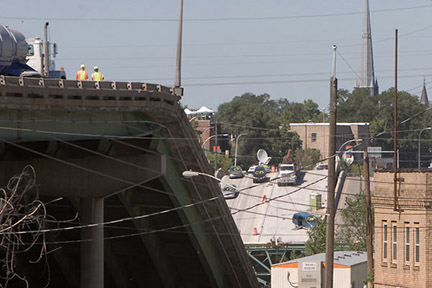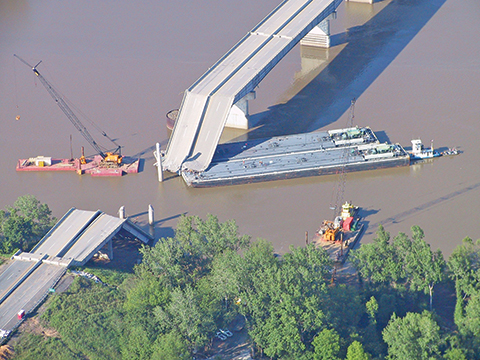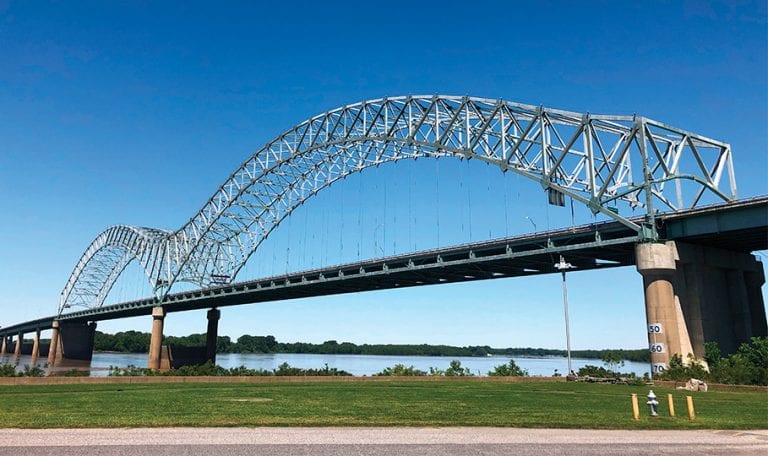The 48-year-old Interstate 40 bridge between Arkansas and Tennessee was rated as being in “fair” condition with a sufficiency factor of 58% before a “significant” fracture was discovered on May 11. The structure has remained closed to traffic since that time as crews work to repair the damage, first stabilizing the bridge to accommodate the equipment needed and then removing and replacing the damaged portion of a 900-foot structural beam.
The Tennessee Department of Transportation (TDOT) said a fracture may be caused by overload, shock, fatigue or stress. A critical fracture could lead to collapse, if not properly repaired and maintained. Either way, it is beneficial to review bridge ratings and maintain inspections to prevent a collapse or further costly damages.
As Arkansas Department of Transportation Director Lorie Tudor said shortly after the damage was found, had the fracture not been discovered when it was, there might have been a “catastrophic” disaster.
Unfortunately, disasters such as this have occurred in the not-so-distant past.
In 2007, the eight-lane I-35 bridge crossing the Mississippi River in Minneapolis collapsed during repaving repairs. Opened in 1967, the bridge was one of Minnesota’s busiest, carrying more than 140,000 vehicles daily. Since 1990, the bridge had been given a rating of “structurally deficient” by the National Transportation Safety Board (NTSB). The term structurally deficient refers to a classification given to a bridge that has components in poor or worsening conditions, according to the National Bridge Inventory. This rating can potentially lead to the structure being undermined and overtopped during a severe weather event or, if neglected, a bridge collapse.

A design flaw involving undersized gusset plates, which connect the structural beams to the bridge, was determined to be a contributing factor in the Minneapolis collapse. There were 13 deaths and 145 seriously injured from the collapse.
In the past 30 years, other major bridge collapses were the Big Bayou Canot Bridge in Mobile, Alabama, in 1993, and the I-40 bridge across the Arkansas River in 2002. A barge struck the I-40 bridge spanning the Arkansas River in Webbers Falls, Oklahoma, resulting in the death of 14 people.
A similar occurrence caused the downfall of the Big Bayou Canot Bridge: A towboat hit the bridge during a fog. NTSB’s initial investigation determined that no one was criminally liable, but a later independent investigation for National Geographic found that welding a simple iron block onto the bridge could have secured it against unintended movement.
In recent years, bridge collapses due the structures being in poor condition have waned. This is due in part to a new rule from the American Association of State Highway and Transportation Officials (AASHTO) that requires new bridges to be designed with a 75-year service life, compared to the previous 50 years. The previous ruling has left the average lifespan of a bridge to be 44 years, according to the American Society of Civil Engineers (ASCE).
These progressions do not mean U.S. bridges are in great shape. At the current pace of bridge improvements, it would take approximately 40 years to repair the current backlog of structurally deficient bridges, ASCE said.

There are a total of 615,318 bridges in the U.S. Of those, 47,223 are considered structurally deficient, according to a report from the American Road and Transportation Builders Association (ARTBA). It would cost $41.8 billion to repair every structurally deficient bridge in the nation, according to the U.S. Department of Transportation (DOT. That number doesn’t include the 79,500 bridges that need complete replacement.
“Unfortunately, 178 million trips are taken across these structurally deficient bridges every day,” the ASCE says. “In recent years, though, as the average age of America’s bridges increases to 44 years, the number of structurally deficient bridges has continued to decline; however, the rate of improvements has slowed.”
Meanwhile, the importance of keeping the nation’s bridges safe has not changed, and new technologies, materials and construction methods have advanced to meet the challenge of maintaining existing bridges.
President Joe Biden proposes to fix the 10 most “economically significant” bridges in need of reconstruction or repair in his infrastructure plan. Ten thousand smaller bridges rated in “poor” condition are also included. However, the American Jobs Plan does not identify which bridges would receive funding. Instead, the plan includes a competitive grant program in which states can display their most worn down and unsound bridges.
In the meantime, the ASCE said, bridge engineers are using materials such as high-performance concrete and steel, as well as corrosion-resistant reinforcement, to help make these spans safer. Engineers are also working to create sensors for new and existing structures that will provide continuous updates on bridge conditions.
Ed Lutgen, a bridge construction maintenance engineer for the Minnesota Department of Transportation, said there are multiple challenges when it comes to repairing bridges.
“We’d like to fix or repair all structurally deficient bridges in the state, but obviously we don’t have funds for all of that, nor does it make all the sense in the world to do that,” he said. “There’s traffic impacts as you’re doing the repair. You have to detour traffic and do it under stage area construction.”
According to the Urban Mobility Report from Texas A&M University’s Transportation Institute, congestion and delay costs drivers $160 billion every year. Truck drivers were represented in $28 billion of the total cost. In 2014, drivers spent 3.1 billion additional gallons of fuel for the nearly 6.9 billion hours they spent in traffic.
“Bridges allow us to make countless vital connections every day through all modes of transportation,” said Tony Dorsey, spokesman for AASHTO. “For example, the I-40 bridge closure impacted both roadway and waterway traffic that was passing on and underneath the bridge. Railroads, both passenger and freight, also depend on bridges, as do pedestrians and bicyclists who ride on bridges to cross otherwise impassable obstacles.”
Ultimately, this affects truck drivers. According to the Associated Press, the I-40 bridge closure has caused delays along the detour route — the nearby I-55 bridge — leading some carriers to change work times for drivers.
In early June, Arkansas Trucking Association President Shannon Newton noted the I-40 bridge closure was costing the trucking industry about $2.4 million a day. On June 28, following efforts by TDOT and the Arkansas Department of Transportation to facilitate traffic flow along I-55 and through West Memphis, Arkansas, Newton reported a marked improvement.
“When the bridge first closed, delays were regularly exceeding an hour. Now … that delay is down to only 15 minutes,” she said, noting that recent traffic data along the detour route suggests the average cost to the trucking industry had dropped to about $936,000 a day. Operational cost data provided by the American Transportation Research Institute (ATRI) shows that the average cost of operating a truck is $71.78 an hour, or $1.20 a minute.
“We commend the Arkansas and Tennessee Departments of Transportation for acting in response to the concerns of the trucking industry and implementing measures to improve traffic flow on this major east-west shipping corridor,” she said.
Hannah Butler is a lover of interesting people, places, photos and the written word. Butler is a former community newspaper reporter and editor for Arkansas Tech University’s student newspaper. Butler is currently finishing up her undergraduate print journalism degree and hopes to pursue higher education. Her work has been featured in at least nine different publications.















One reason for the lack of adequate bridge and highway maintenance in Arkansas is
ArDOT’s obsession with building new freeways and widening existing freeways rather than maintaining its assets properly.